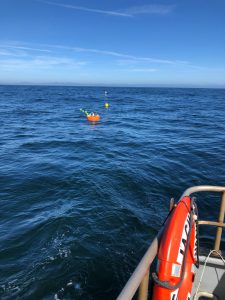A coalition of researchers funded by the NOAA Monitoring and Event Response for Harmful Algal Blooms (MERHAB) Program recently came together to co-locate an Environmental Sample Processor (ESP) off the Washington State continental shelf. The moored system will provide a powerful observing platform for identifying harmful algal bloom (HAB) response to changing environmental factors. The work is led by researchers at University of Washington, NOAA Northwest Fisheries Science Center, NCCOS, Monterey Bay Aquarium Research Institute, McLane Research Laboratories, Quileute Natural Resources, and the Olympic Coast National Marine Sanctuary.

Timely observations are the foundation of a better understanding of our ecosystems and how they are impacted by a myriad of stressors. Domoic acid (DA), a toxin resulting from Pseudo-nitzschia HABs in the Pacific Northwest, is one of those stressors but our understanding of its formation and dispersal is still lacking.
To fill that gap, funding for the NOAA MERHAB project is supporting a sixth deployment of an ESP at the Northeast Enhanced Moored Observatory, a set of moored oceanographic instruments on the Continental Shelf 15 miles off the coast of Washington. The ESP, affectionately named ESPeddie, will provide the researchers with near real-time observations of DA levels 6 days per week for the next 6 weeks. These observations can then be coupled with the environmental conditions recorded by the oceanographic instruments that comprise the observatory to better understand DA dynamics.
The data from ESPeddie will be available through the NANOOS Data Visualization System (NVS) and the “Real-time HABs” website at: http://www.nanoos.org/products/real-time_habs/home.php by clicking on the ESP Now tab. This effort is demonstrating how sustained ESP HAB observations can enhance future PNW HAB Bulletins.
Area resource managers are already anticipating using data from ESPeddie to manage their seasonal fisheries, such as the extremely popular razor clam fishery. During blooms, DA can accumulate in the clams and other shellfish making them dangerous for humans to consume. According to Dan Ayres, Coastal Shellfish Manager at the Washington Department of Fish and Wildlife, “We are planning to soon release dates that will begin recreational harvest opportunities in mid-September. We’ll be looking to Eddie for any signs of trouble.”

For more information about the ESPeddie deployment, please feel free to contact the project PIs in charge of the deployment, Stephanie Moore (stephanie.moore@noaa.gov) and Nick Adams (Nicolaus.Adams@noaa.gov), or John Mickettt (mickett@uw.edu), the project Lead PI. For information on the research program, contact Felix Martinez (felix.martinez@noaa.gov).
